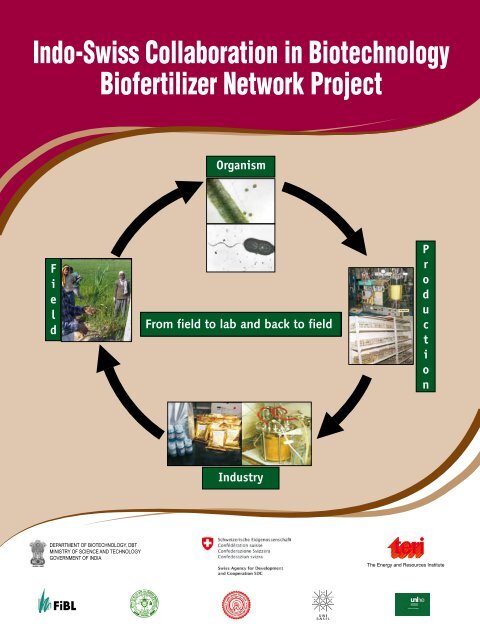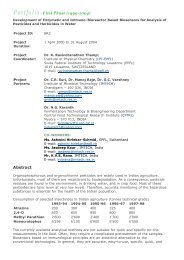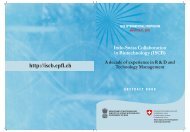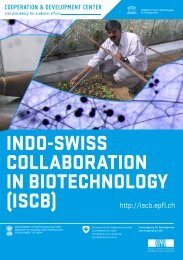BFNet - ISCB
BFNet - ISCB
BFNet - ISCB
Create successful ePaper yourself
Turn your PDF publications into a flip-book with our unique Google optimized e-Paper software.
Indo-Swiss Collaboration in Biotechnology<br />
Biofertilizer Network Project<br />
F<br />
i<br />
e<br />
l<br />
d<br />
DEPARTMENT OF BIOTECHNOLOGY, DBT<br />
MINISTRY OF SCIENCE AND TECHNOLOGY<br />
GOVERNMENT OF INDIA<br />
Organism<br />
From Field field to lab Lab and back to field<br />
Field<br />
Industry<br />
P<br />
r<br />
o<br />
d<br />
u<br />
c<br />
t<br />
i<br />
o<br />
n
Extraradical mycelium and spores of AMF<br />
Black gram, wheat and rice seeds coated with<br />
AMF & PGPR formulations<br />
Field trial<br />
<strong>ISCB</strong> Biofertilizer Network Project<br />
Agricultural production worldwide is faced with severe problems<br />
caused by climate change. Modern bio-technologies such as<br />
biofertilizers consisting of arbuscular mycorrhizal fungi (AMF) and<br />
plant growth-promoting rhizobacteria (PGPR) are a powerful tool<br />
to improve soil fertility and sustainable production, rendering agrisystems<br />
more stress-tolerant. Moreover, they help to reduce the<br />
amount of energy demanding inputs, such as chemical fertilizers.<br />
Biofertilizers contribute to mitigation of and adaptation to<br />
climate change.<br />
This project is part of an Indo-Swiss Collaboration in Biotechnology<br />
(<strong>ISCB</strong>), dedicated to biofertilizers. It is referred to as <strong>ISCB</strong> Biofertilizer<br />
project phase III, as it is a continuation of two previous phases within<br />
this programme. It essentially aims to deliver a tested and validated<br />
combined bio-inoculant product – based on AMF and PGPR - for<br />
application in sustainable and low-input agriculture especially for<br />
wheat-based cropping systems in India.<br />
The project involves the core competencies of multi-institutions<br />
of India (TERI, GBPUAT, BU, and IIT-D) and Switzerland (UB, UN<br />
and FiBL) to develop, test, and monitor the combined bio-inoculant<br />
product in various multi-location fields, validation and demonstration<br />
trials– in order to increase their practical use in tune with existing<br />
agricultural practices as well as some fundamental research. It also<br />
includes the unique capability for identification and tracking of the<br />
bio-inoculant’s components after application in the field developed<br />
during phase II of <strong>ISCB</strong> activity. The following institutes are/were<br />
involved:<br />
• The Energy and Resources Institute (TERI), New Delhi, India<br />
• GB Pant University for Agriculture and Technology (GBPUAT),<br />
Pantnagar, India<br />
• Barkatullah University (BU), Bhopal, India<br />
• Indian Institute of Technology, Delhi (IIT-D), India<br />
• University of Basel (UB), Switzerland<br />
• University of Neuchâtel (UN), Switzerland<br />
• Research Institute of Organic Agriculture (FiBL), Switzerland
University of Basel<br />
Arbuscular mycorrhizal fungi (AMF) and plant growth-promoting rhizobacteria<br />
(PGPR) are in the focus of <strong>ISCB</strong> as potential “biofertilizers” in sustainable agriculture.<br />
In order to make use of such biofertilizers in a reliable fashion, it is necessary to have<br />
molecular diagnostic tools for their identification and quantification. In this context,<br />
the team of Andres Wiemken of the Botanical Institute of the University of Basel has<br />
worked for many years to develop and apply microsatellite markers for AMF strains,<br />
and the team of Thomas Boller of the same institute has joined in more recently to<br />
produce similar markers for PGPR, based on preceding work by the group of Michel<br />
Aragno of the University of Neuchâtel.<br />
The Energy and Resources Institute<br />
This project utilizes TERI’s core competency for mass production of AMF using<br />
Root Organ Culture. This mass production system uses root-inducing transfer-DNAtransformed<br />
roots of a host plant to develop the symbiosis on a specific medium<br />
in vitro, which provides pure, viable, contamination-free inoculum using least space.<br />
TERI team led by Alok Adholeya has collected (139 isolates), maintained, and selected<br />
functionally efficient AMF for wheat cropping system (LL2 consortia, TERI commercial)<br />
in the first phase. TERI team then tested the selected AMF along with selected PGPR<br />
from GBPUAT in multilocation field research trials (of wheat-legume cropping system)<br />
in the second phase and has developed the formulation for AMF for field application.<br />
In the third phase, TERI is continuing testing AMF & PGPR in research trials, validation<br />
trials, and farmers’ field demonstration trials. TERI is also involved in developing joint<br />
formulation of AMF & PGPR using its well known expertise in lyophilization.<br />
Research Institute of Organic Agriculture<br />
The Soil Sciences Division at the Research Institute of Organic Agriculture (FiBL)<br />
developed its agronomic and conceptual expertise over several decades of applied<br />
research. Since the beginning of <strong>ISCB</strong> Phase II, it acts as a project partner for<br />
important technical and scientific questions, including regular field visits in India,<br />
within the Biofertilizer network. FiBL develops the concepts in collaboration with the<br />
project partners, prepares the planning documents for the field trials and organises<br />
the compilation, validation, statistical analysis and evaluation of the pooled data<br />
obtained from the field trials by the Indian partners.<br />
Indian Institute of Technology, Delhi<br />
The IIT-D group joined the Biofertilizer project in Phase II. It was jointly led by<br />
Prof. Vikram Sahai (PI till September 2010 and Project Consultant thereafter)<br />
and Prof Virendra S Bisaria (PI since October 2010). The group developed mass<br />
Prof. Andres Wiemken, BIB (PI)<br />
“The current high-input agriculture<br />
is not sustainable worldwide. Now,<br />
India has the chance to introduce<br />
environmentally friendly agriculture<br />
based on biofertilizers and mixed<br />
cropping fostering agrobiodiversity.”<br />
Prof. Thomas Boller, BIB (PI)<br />
“Basic research is urgently needed to<br />
establish reliable molecular markers for<br />
individual biofertilizer strains in order to<br />
apply them in sustainable agriculture.”<br />
Dr Alok Adholeya, TERI<br />
(PI and Indian Coordinator)<br />
“Comparatively low yielding cropping<br />
systems and deteriorating soil fertility<br />
needed a biological solution, which is<br />
now developed and amply evaluated.<br />
A new era of biological agents is on the<br />
offering.”<br />
Dr Paul Mäder, FiBL<br />
(PI and Swiss Coordinator)<br />
“Biofertilizers…a good option for<br />
sustainable agriculture less dependent<br />
on limited phosphorus stocks.”<br />
Prof. V S Bisaria,IIT-D (PI)<br />
“Bioprocessing – a sustainable<br />
way of life.”
Prof. Vikram Sahai<br />
(Consultant & former PI)<br />
“Well researched biofertilizers have<br />
paved the way for safe and sustainable<br />
agriculture”<br />
Prof. Michel Aragno<br />
(Consultant and former PI)<br />
“The main issue of this project is not<br />
just to have developed a product, but<br />
to have shown the way to scientists and<br />
agronomists in the future of biofertilizer<br />
research. As Louis Pasteur said, ‘there<br />
are no applied sciences, but there are<br />
applications of science.’”<br />
Dr Padruot Fried<br />
(Advisor, BF Net & Member<br />
Steering Committee, <strong>ISCB</strong>)<br />
“Positive plant-microbe interactions will<br />
also be found in other crops, increasing<br />
their nutritional value and fostering<br />
environmentally friendly production.”<br />
Prof. B N Johri<br />
(Consultant and former PI)<br />
“Selection of rhizobacteria R62 and<br />
R81 has been the hallmark of this<br />
collaboration. What team work can do, is<br />
the end result in the form of a product !”<br />
Dr A K Sharma, GBPUAT (PI)<br />
"Research on biofertilizer should<br />
be strengthened with strong basic<br />
understanding of functionality<br />
of organisms. Second generation<br />
biofertilizers having robust nature to<br />
sustain even under stressed environments<br />
need to be searched"<br />
multiplication technology of PGPR strains at bench and pilot scale through submerged<br />
cultivation in bioreactors, and also developed appropriate bio-inoculant’s formulations.<br />
The group has modified and optimized Schlegel’s synthetic medium for cultivation of<br />
fluorescent pseudomonads R62 and R81 to produce higher biomass and other desired<br />
metabolites, such as siderophore and 2,4- diacetylphloroglucinol (DAPG) in shake flask<br />
as well as in bioreactors. The group has developed a fed-batch process strategy and<br />
process control software for enhanced production of cell mass and DAPG for the<br />
PGPR strains. The output of one fed - batch run produces approximately twenty times<br />
more carrier based bio-inoculant’s formulations compared to that of a conventional<br />
batch run.<br />
University of Neuchâtel<br />
Phase 1: lsolation, selection, and identification of promising PGPR strains (in<br />
collaboration with GBPUAT), based on plant-growth promoting activities; responses<br />
of bacterial communities to the presence of AMF in the mycorhizosphere and<br />
hyphosphere; in vitro study of interactions between the selected strains and AMF (in<br />
collaboration with TERI); study of AMF-spores associated bacteria (in collaboration<br />
with BIB)<br />
Phase 2: Molecular characterization, at strain level, of the selected R62 and R81<br />
strains (Pseudomonas jessenii, resp. P. synxantha); definition of strain-specific primers<br />
(R62) allowing field monitoring; establishment of strain-specific PFGE (Pulsed-Field<br />
Gel Electrophoresis); batch cultivation of both strains in synthetic media, and test of<br />
potential C-sources (in collaboration with IIT)<br />
Phase 3: Preparation of phase III application, taken up by UB after M Aragno’s<br />
retirement; M Aragno continued to be associated with the programme as <strong>ISCB</strong><br />
consultant.<br />
Govind Ballabh Pant University of<br />
Agriculture and Technology<br />
Phase I: The GBPUAT group led by Prof. B N Johri has played a key role in the<br />
selection of PGPR strains along with UN group. The strains were identified and<br />
characterized for their functionality and tested at a very small scale for the plant<br />
growth promotion.<br />
Phase II: The group led by Dr A K Sharma developed the inoculums of PGPRs and set<br />
up the field trials at different level at farmers’ fields under rice – wheat and wheat –<br />
pulse system both in plains and hills where the conditions are rainfed especially for<br />
wheat – pulse system.<br />
Phase III: AMF and PGPRs inoculum developed by TERI and IIT was further tested<br />
in validation and demonstration trials. Genetic stability and marker development<br />
was carried out in collaboration with UN and continued with UB. GBPUAT has also<br />
developed formulation of PGPRs.
Achievements from Phase I (2000–2004)<br />
Wheat field<br />
• Collection of 3000 PGPR and 139<br />
AMF isolates from wheat fields of<br />
six different sites of India<br />
• Maintenance of collected PGPR and<br />
AMF germplasm<br />
• Testing of AMF and PGPR for their<br />
functional and synergistic properties<br />
• Screening of AMF and PGPR in<br />
greenhouse for the plant growth<br />
promotion<br />
• Selection of AMF (natural<br />
consortium consisting of 4 or more<br />
AMF species) and PGPR strains<br />
(R62-Pseudomonas jessenii & R81-<br />
Pseudomonas synxantha)<br />
• Development of Root Organ<br />
Culture and in vitro mass production<br />
technology for AMF single strains<br />
and consortia.<br />
Trap culture of AMF<br />
Root Organ Culture of AMF<br />
single strain<br />
In vitro mass production<br />
technology for AMF<br />
Testing of PGPR functions Pot trials AMF and PGPR synergism
Achievements from Phase II (2005–2008)<br />
Multi-location and multi-year field testing<br />
Wheat field (March 2007)<br />
Mass production of PGPR<br />
Black Gram field (September 2008) Rice field (October 2007)<br />
Treatments in 4 replicates<br />
T1 No inoculation of AMF and PGPR<br />
T2 Natural AMF consortium produced via trap<br />
cultures and containing at least 4 Glomus species<br />
T3 Single Glomus species isolate obtained from<br />
natural consortium and successfully produced invitro<br />
T4 Pf = fluorescent Pseudomonas (R62 + R81)<br />
T5 Natural consortium of AMF (T2) and fluorescent<br />
Pseudomonas (T4) together<br />
T6 Single Glomus species isolate (T3) and<br />
fluorescent Pseudomonas (T4) together<br />
T7 Pre-commercialized AMF by TERI produced in<br />
vitro as reference product<br />
Crops<br />
Wheat Triticum aestivum (L.) variety UP2338<br />
Rice Oryza sativa (L.) variety Pant Dhan 4<br />
Black gram Vigna mungo (L.) Hepper,<br />
variety Pant Urd 35<br />
Fertilization<br />
Zero and farmers practice<br />
Field locations in India:<br />
1. Ujhani, Budaun (Uttar<br />
Pradesh)<br />
2. Bhavanipur, Budaun (Uttar<br />
Pradesh)<br />
3. Salari I, Nainital<br />
(Uttarakhand)<br />
4. Salari II, Nainital<br />
(Uttarakhand)<br />
5. Shyampur, Haridwar,<br />
(Uttarakhand)<br />
6. Mandori, Palwal (Haryana)<br />
• Biofertilizer growth response of crops was highest at marginal site and biofertilizers were also effective at<br />
farmers practice fertilization.<br />
• Yield increase of wheat after dual inoculation of AMF (Natural AMF consortium produced via trap cultures and<br />
containing at least 4 Glomus species) and PGPR (R61+R81) was 41% (n=11).<br />
• Biofertilizers in rice and black gram were only effective in the second year of application.<br />
• Sesbania as a leguminous green manure plant substantially increased yields of rice and wheat (25%–27%).<br />
• P, K, Zn, Cu, and Mn of wheat and rice and crude protein content in wheat were significantly higher after<br />
inoculation of AMF and PGPR. This is most relevant with respect to the diet of the Indian population, since<br />
these plant species are staple food crops.<br />
• Fermenter based technology for mass cultivation of PGPR strains was developed.
Mean grain yield of wheat, rice, and black gram from two cropping seasons<br />
Inoculation Wheat Rice Black Gram<br />
LS Mean<br />
(t/ha*)<br />
% LS Mean<br />
(t/ha*)<br />
% LS Mean<br />
(t/ha*)<br />
T1 No inoculation of AMF and PGPR 2.36 c 100 2.90 a 100 0.307 b 100<br />
T2 Natural AMF consortium produced via trap cultures<br />
and containing at least 4 Glomus species<br />
3.05 b 129 3.05 a 105 0.382 a 124<br />
T4 Pf = fluorescent Pseudomonas (R62 + R81) 3.09 ab 131 3.15 a 109 0.357 ab 116<br />
T5 Natural consortium of AMF (T2) and fluorescent<br />
Pseudomonas (T4) together<br />
T7 Pre-commercialized AMF by TERI produced in vitro<br />
as reference product<br />
3.35 a 141 3.14 a 108 0.345 ab 112<br />
3.03 b 128 2.99 a 103 0.372 a 121<br />
*Mean grain yield of wheat, rice, and black gram from two cropping seasons. Grain yield of wheat grown in 2006 and 2007<br />
and of rice and black gram grown in 2005 and 2006 after four inoculation treatments at two fertilization levels at three to seven<br />
locations. Calculated means of 14 harvests of wheat and six harvests each of rice and black gram.<br />
Food quality of wheat, rice, and black gram from two cropping seasons<br />
a) Wheat b) Rice c) Black Gram<br />
Crude protein***<br />
150<br />
Crude protein*<br />
150<br />
Crude protein<br />
150<br />
Ash*** 125 P*** Ash*** 125 P*** Ash 125<br />
P***<br />
100 100 100<br />
75 75 75<br />
Mn** 50 K*** Mn** 50 K** Mn<br />
50<br />
K***<br />
Zn*** Cu*** Zn** Cu* Zn<br />
Cu<br />
Fe** Fe Fe<br />
Food quality as indicated by crude protein, macro- and microelement concentration of wheat, rice, and black gram<br />
grains. a) Wheat grown in 2006 and 2007, b) rice and c) black gram grown in 2005 and 2006 after four inoculation<br />
treatments across two fertilizer levels. Calculated means in percent (control = 100%) of four harvests of wheat and<br />
two harvests of rice and black gram at two locations.<br />
Reference<br />
Paul Mäder, Franziska Kaiser, Alok Adholeya, Reena Singh, Harminder S. Uppal, Anil K. Sharma, Rashmi Srivastava, Vikram<br />
Sahai, Michel Aragno, Andres Wiemken, Bhavdish N. Johri, Padruot M. Fried (2011), Soil Biology & Biochemistry 43, 609-619<br />
Research trials were initiated during Phase II and terminated (after five cropping<br />
seasons) in Phase III<br />
Wheat yield increase by around 40% was confirmed.<br />
Although AMF and PGPR were selected for wheat, yields was also found to be increased in rice and black gram.<br />
Crop quality and soil quality was found to be improved with the co-inoculation of AMF & PGPR.<br />
%<br />
T1<br />
T2<br />
T4<br />
T5<br />
T7
Achievements from Phase III (2008–2012)<br />
Crop rotation<br />
Wheat – Rice, Wheat – Cotton,<br />
Wheat – Pulse – Rice<br />
Varieties<br />
PBW-343, PBW-373, PBW-550, DBW-17,<br />
HD-2258, HD-2851, HD-2894, JW-273 and<br />
WH-711<br />
Inputs<br />
100% RDF*, 75% RDF*, 50% RDF* treatments<br />
with Bioinoculants (AMF + PGPR) in<br />
comparison with Control Plots of 100% RDF* (*<br />
State Agricultural University’s Recommended<br />
Dose of Chemical Fertilizer)<br />
Findings<br />
• Co-inoculation of AMF and PGPR at<br />
100% RDF improved wheat grain yield<br />
up to 12%.<br />
• Inoculation was found to be effective in all<br />
the tested agro-climatic regions and wheat<br />
based crop rotations.<br />
• No yield decline at 75% RDF (& at 50% in<br />
some fields) was observed when<br />
co- inoculation was applied to wheat,<br />
compare to 100% RDF without inoculation.<br />
Formulation<br />
AMF has long shelf life (up to 5 years) at low<br />
moisture (5%) at ambient temperatures<br />
(upto 45 °C)<br />
Since PGPR has shorter shelf life being<br />
non-sporulating isolates especially under hot<br />
climate which very much prevails under Indian<br />
conditions, two techniques (flocculation and<br />
lyophilization) have been attempted which<br />
could sustain the shelf life of PGPRs (R62 and<br />
R81) until 6 months without significant loss in<br />
the cell count. The further refinement of these<br />
leads is necessary to develop finished product<br />
packaged appropriately for prolong shelf<br />
life and effective delivery on seeds.<br />
For joint formulation, two approaches were<br />
tested extensively<br />
• Lyophilization<br />
• Flocculation<br />
For further information, contact<br />
Dr Alok Adholeya, Director<br />
Biotechnology and Management of Bioresources Division<br />
TERI, Darbari Seth Block, Lodhi Road<br />
New Delhi 110 003, INDIA<br />
Tel. +91 11 24682100 or +91 11 41504900<br />
E-mail aloka@teri.res.in • Web www.teriin.org<br />
Field Trial Locations in Phase III<br />
Rajasthan<br />
Punjab<br />
Haryana<br />
Madhya Pradesh<br />
Uttar Pradesh<br />
Bihar<br />
Middle Gangetic Plains Region: UP, Bihar<br />
Upper Gangetic Plains Region: UP<br />
Trans-Gangetic Plains Region: Punjab, Haryana and Rajasthan<br />
Central Plateau and Hills Region: MP, Rajasthan<br />
Dr Paul Mäder, Head of Soil Sciences Division<br />
Research Institute of Organic Agriculture (FiBL)<br />
Ackerstrasse 21<br />
5070 Frick, Switzerland<br />
Tel. +41 62 865 72 32<br />
E-mail paul.maeder@fibl.org<br />
Web www.fibl.org





